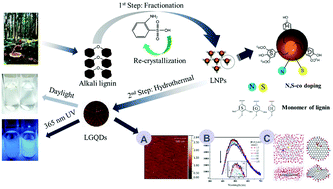Direct transformation of lignin into fluorescence-switchable graphene quantum dots and their application in ultrasensitive profiling of a physiological oxidant†
Abstract
Biomass transformation into value-added products offers a solution to the end-up issue of agricultural and forestry wastes and provides a sustainable approach towards a circular material economy. Here we report a green fractionation technology for converting alkali lignin (AL) into graphene quantum dots (GQDs) which are glowing carbon nano-crystals as new guiding light for a spectrum of novel applications. AL is rapidly fractionated by an acid hydrotrope and recovered with an aromatic functionality as GQDs under mild conditions. In addition, the acid-hydrotrope can be easily recycled to restore its environmental sustainability. The as-prepared lignin-based GQDs (LGQDs) exhibit a nanoscopic few-layer structure, along with bright fluorescence, water solubility, long-term photostability, and excellent biocompatibility. Benefitting from these alluring properties, LGQDs are applied as sensitive fluorescence-switchable probes for detecting H2O2 which is a common physiological oxidant in biological systems. They exhibit bright excitonic fluorescence, along with significant fluorescence quenching in response to the presence of H2O2 with a concentration as low as 0.13 nM. The ultrasensitivity of LGQDs for detecting H2O2 is explored by density functional theory (DFT) calculations and the results show that the fluorescence mechanism of LGQDs is dominated by the intramolecular charge transfer (ICT) behavior, which is proposed for the first time and subsequently validated by a series of control experiments. This study offers a promising and sustainable approach for synthesis of S, N co-doped graphene quantum dots as ultrasensitive biosensors from low-cost biomass. In addition, the theoretical results highlight a deep understanding on the photoluminescence phenomenon of LGQDs and more generally biomass-based GQDs.



 Please wait while we load your content...
Please wait while we load your content...